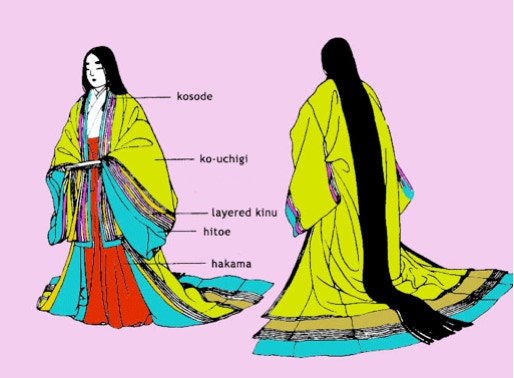fashion
Heian society was extremely fashion-conscious. Aristocratic women did not show their faces in public, but the hems and sleeves of their robes were visible from behind blinds and screens. A lady showed her taste in dress by an artful layering of the different color combinations of her many robes. Murasaki Shikibu's keen eye for fashion is revealed in her descriptions of the dress of her heroines in The Tale of Genji. She also spends a great deal of time describing women's clothing in her Diary.
In modern Japan the "Heian look" is referred to by the term jūni-hitoe, meaning "twelve layers of robes." As we know from Murasaki's Diary and other sources, women did not necessarily limit themselves to twelve. And in in the sweltering Kyoto summer they would only have worn one-of transparent gauze. The indispensable basis of women's dress consisted of a kimono-shaped underrobe (kosode) and long, loose trousers (nagabakama) tied at the waist. Over this was worn an unlined, wide sleeved gown called hitoe. This gown was larger than the layered sets worn over it, and showed prominently at hem, neckline, and sleeve opening. On top of this came a number of gowns called kinu. The basic set was five, but there could be as many as thirty—such as Murasaki's friend Lady Saishō wore on page 364 of my tale.
According to season, these layered gowns could be lined or unlined, and the linings could match or be a different color than the dress itself. Usually these layered robes were dyed in solid colors. Patterned weaves occurred on the "mantle" or top layer only. In informal settings, the top layer was a gown called ko-uchigi. For formal occasions, an over-robe called uwagi was worn and a short boxy "Chinese jacket" (karaginu) worn on top of that. The finishing touch was a train-like garment called a mo that was tied around the waist and trailed in back.

in the Heian style...

